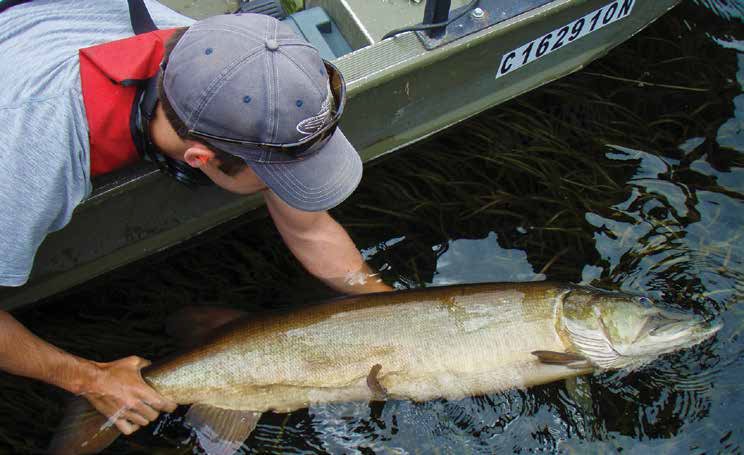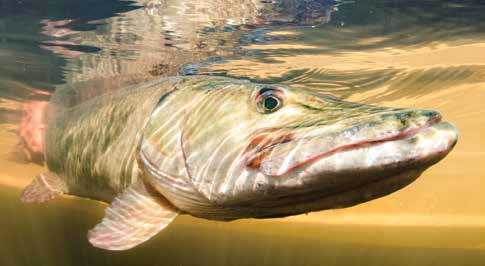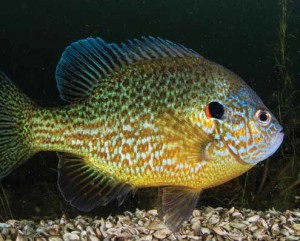
A 49-inch Muskie is released into the Rideau River near Kemptville as part of a research project. Photo by Sean Landsman
Sean Landsman
The Rideau River in Old Ottawa East is one of the best features of our neighbourhood. But did you know that there are fish swimming around the dock at Clegg Avenue that are longer than your kids are tall? Or that there are over 40 species of fishes that call the Rideau home? Let’s take a look at a few of the more popular fish species.
Muskellunge, or “muskies” for short, are the kings and queens of the Rideau River. Capable of reaching lengths in excess of five feet and weights over 60 pounds, muskies are the largest fish species swimming in the Rideau. Muskies in the Rideau are usually between 30 and 50 inches, but fish over 50 inches are not unheard of. These large predators feed on whatever they can get their mouths around – from other fishes to ducklings and small rodents. They are, however, relatively rare and thus make for a challenging fish to target by angling, but when they are caught, most are released.

The muskie is one of the rarest sportfishes in the Rideau and a favourite of anglers. Photo by Sean Landsman
Walleye are arguably the tastiest fish in the Rideau. Some people call them “Marble Eyes” because of their extremely well-developed tapetum lucidum, which is a layer of tissue in the eye that reflects back any available light. Biologists can actually count walleye when they spawn simply by shining a light into the water and counting the number of eyes that reflect back!
Animals that have well-developed tapetum lucidums, like cats, are highly effective nighttime hunters. Walleye are mostly fish eaters, but also eat leeches, crayfish, and other invertebrates. They can be caught during the day, but the best fishing often occurs at night or dawn and dusk. Walleye in the Rideau can reach lengths in excess of 26 inches.
Largemouth Bass (aka “Bucket Mouths”) and Smallmouth Bass (aka “bronze backs”) are perhaps the most popular sportfishes in the entire Rideau River system. Bass are generalist feeders, eating whatever they can engulf in their mouths. Following the act of spawning in the spring, male bass are left to take care of the young. Male bass routinely win “Dad of the Year” awards for vigorously defending their babies from all the other fishes that want to pillage the nests. The males will stay with their broods from the egg stage until the young are able to swim on their own. Most bass you’ll find in the Rideau are between 10-18 inches, with the occasional individual above 20 inches.
Two of the most ubiquitous species in the Rideau are the Bluegill and Pumpkinseed Sunfishes, which many often lump together and refer to simply as “sunfish.” Bluegills and Pumpkinseeds also display parental care behaviour like bass. Bluegills are unique, however, in that they not only form colonies of nests, but also because the males display two different alternative spawning strategies. “Sneaker” males dart in and fertilize eggs when the larger, dominant male isn’t looking. “Satellite” males take on the appearance of females, effectively tricking the larger male into thinking he’s spawning with two females!
A shallow, bottom-dwelling member of the Catfishes, the Brown Bullhead use their sensitive barbels to root out food on the river bottom. These fish also display parental care behaviour, digging a hole in the river bottom where they judiciously defend their young. Brown bullheads are relatively small as far as catfishes are concerned, usually topping out around 14-15 inches.
The diversity of fish species in the Rideau is worth celebrating, and just another reason we’re so lucky to call Old Ottawa East home.







